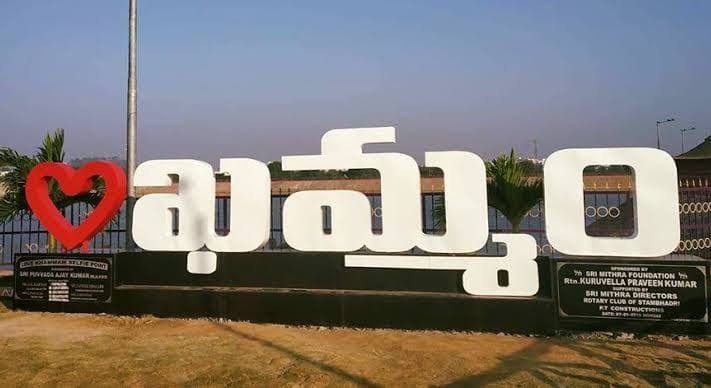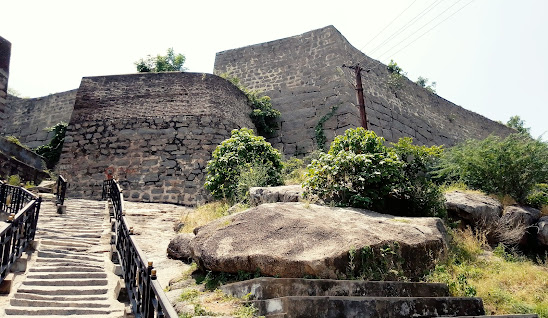
History :
The name Khammam, which means a pillar is named after lord Narasimha Swamy, the presiding deity of Narasimhaswamy Gutta, an important pilgrimage site for the locals. Because of the presence of Lord Narasimhaswami temple in Khammam, the city was named Sthambadri earlier. The city is located on the banks of a river called Munneru which is a tributary of the Krishna River. Khammam district has a lot of historical importance in Telangana.
Geographical profile
The Khammam district, which is a part of Telangana region, has between 16”45’ and 18”35’ of Northern Latitude and 79”47’ and 80”47’ of the Eastern Longitude. The district is bounded on the North by Chattishghar and Orissa states, on the East by East Godavari and West Godavari, on the South by Krishna and on the West by Nalgonda and Warangal The central and eastern parts of the district are mainly hilly.
Rivers
The important rivers that flow through the district are the Godavari, Sabari, Kinnerasani, Munneru, Paleru, Akeru and Wyra. The river Munneru rising in the Warangal district flows South wards passing through Kothagudem and Khammam revenue divisions. The river Akeru, which also rises in Warangal district, flows in the South-Eastern direction and joins the Munneru at Thirdala village. The river Paleru flows almost parallel to Munneru and passes through Kakaravai village of Tirumalaipalem Wyra flows towards South direction and joins Munneru river in Krishna district.
Climate and Rainfall
The climate is comparatively equitable and although it is very hot in May with mercury rising upto 40.7c. During the year 879.1 mm Rainfall is received as against a Normal of 1124.0 mm in Khammam while observing 21.78% of deficiency.
Soil
The soil in the district is mostly sandy loams in the South of river Godavari, the black soil in Madhira mandal and the areas adjoining the river Godavari are fertile and rich like the delta lands of Godavari The predominant soil in the district is Chalaka (43%), Dubba (28%) and Black soil (29%).
Flora & Fauna The forest wealth chiefly comprises teak, nallamaddi, chandra and bamboo. About 4% of the total Geographical area of the district is under forest cover. The total forest area in the district covers 7,59,438 hectares. The flora of the district can be broadly classified into timber, softwood, fuel, bamboo shrubs, climbers various kinds of grabber and several other minor forest produce yielding spices etc. The district is noted for fauna. The tracts tying on either side of the Godavari are the repositories of wildlife. The species of wildlife found in the district can be classified as quadrupeds, avers and reptiles and birds. A number of poisonous and non-poisonous snakes are found all over the district.
District Composition
Khammam town was part of the larger Warangal district till October 1st, 1953. Five taluks of the Warangal district viz., Khammam, Madhira, Yellandu, Burgampadu and Palwancha (now Kothagudem) were carved out and a new district with Khammam as district head quarters was formed. In 1985, following the introduction of mandal system, the district was divided into 46 mandals in four revenue divisions viz., Khammam, Kothagudem, Palwancha & Bhadrachalam. There are 6 towns / Municipalities in the district. They are Khammam (Municipality), Kothagudem (Municipality), Yellandu (Municipality), Palwancha (Municipality), Sathupally (Municipality), Manuguru (Municipality). Out of 46 mandals, 29 mandals are fully in ST sub-plan area and 2 mandals are partially located in ST sub-plan area. The district comprises 1242 Revenue villages (including with 894 schedules villages and 348 non scheduled villages), 128 deserted villages and 771 Gram panchayats (18 major gram panchayats and 753 minor gram panchayats).
Area, Population and Other related characteristics
The district comprises an area of 16,029 sq.kms with a density of population of 174 persons per sq.km. There are 1242 villages exist in Khammam district of which 1114 are the inhabited villages and the remaining are uninhabited villages.
As per 2011 census, the total population of the district is 27,97,370. It accounts for 3.3 percent of the total population of the state. The male population of the district is 13,90,988 and this forms 49.72% of the district and 3.2 percent of the state male population. Similarly the female population of the district is 14,06,382 and this form 50.28% of the district and 3.3 percent of the state female population.
As per the latest 2011 census, the rural population of the district is 21,41,459 which constitutes 80.19% of the district population and 3.73% to total of state rural population. Similarly the urban population of the district spread over in 9 towns is 6,55,911 constituting 19.81% of the district population at 2.46% of the state urban population.
As per 2011 census, the scheduled caste population of the district is 4,62,896 which is 16.54% of the district population and 3.46% of the state scheduled caste population. Similarly the Scheduled Tribe population of the district is 7,65,565 which accounts for 26.47% of the district at 13.59% of the state scheduled tribe population.
The Decennial growth of the population in the district from 2001 census to 2011 census is 16.39 percent. The density of population of the district according to 2011 census is 174 persons per sq.km as against 277 persons per sq.km for the state. The literacy rate of the district is 65.46% as against 60.47% of the state literacy rate. The sex ratio of the district is 1011 females per 1000 males as against 978 of the state. The working population as per 2011 census is 14,10,062 accounting 50.41% of district population at 3.57% of the state working population.
Parliament and Assembly Constituencies
The district shares Khammam parliamentary constituency and 5 Assembly Constituencies.
- Khammam
- Palair
- Madhira
- Wyra
- Sathupally



